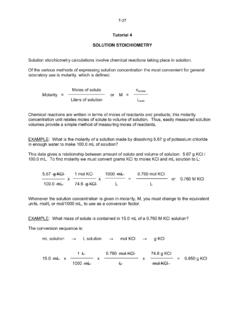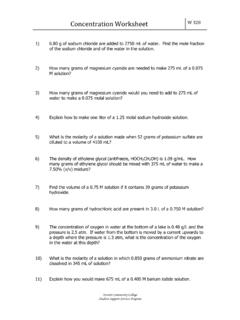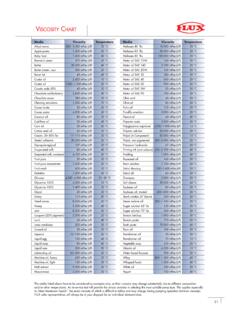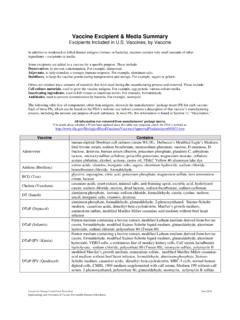Transcription of Standardization of a NaOH Solution with Potassium …
1 1 Standardization of a NaOH Solution with Potassium Hydrogen Phthalate (KHP) and Titration of Vinegar with Standardized NaOH Objective You will determine the concentration (standardize) of an unknown Solution of NaOH using the primary standard, Potassium hydrogen phthalate. Determine the concentration of acetic acid of vinegar, in terms of % (m/m). Introduction Sodium hydroxide is hygroscopic and absorbs water from the air when you place it on the balance for massing. This water will prevent you from being able to find the exact mass of sodium hydroxide . In order to determine the exact concentration of a sodium hydroxide Solution you must standardize it by titrating with a solid acid that is not hygroscopic. Potassium hydrogen phthalate, KHC8H4O4 (abbreviated KHP), is a non-hygroscopic, crystalline, solid that behaves as a monoprotic acid. It is water soluble and available in high purity. Because of its high purity, you can determine the number of moles of KHP directly from its mass and it is referred to as a primary standard.
2 You will use this primary standard to determine the concentration of a sodium hydroxide Solution . The structure of KHP is shown below: When KHP and a base a reacted, a neutralization reaction occurs that is represented by the following equation: KHC8H4O4 (aq) + NaOH(aq) KNaC8H4O4 (aq) + H2O(l) The net ionic equation is: HC8H4O4-1(aq) + OH-(aq) C8H4O4-2 (aq) + H2O(l) The reaction can be considered to proceed completely to the right. If exactly equivalent amounts of acid or base are used so that neither reactant is present in excess the Solution is said to be at the equivalence point. If only monoprotic acids and bases are used (those that furnish or react with one H+ per molecule), then at the equivalence point the number of moles of acid equal the number of moles of base (moles acid = moles base). An acid-base titration is a procedure used to compare the amount (moles) of acid in one sample with the amount (moles) of base in another. In this laboratory exercise you will carry out such a titration to standardize (determine the exact concentration of) a NaOH Solution by measuring accurately how many milliliters of it are required to exactly neutralize a known amount of acid.
3 A buret filled with the titrant (NaOH Solution ) is used to measure the volume of NaOH Solution added to the known amount of acid in a flask. An indicator is added to signal the endpoint has been reached. The indicator is a weak acid (or base) itself and reacts with some of the titrant to produce the color change The endpoint occurs when all the acid has been neutralized and the Solution composition changes suddenly from excess acid to excess base. When the endpoint is reached the addition of titrant should be stopped. Since the indicator reacts with some of the titrant and the indicator may not change at the exact pH of the equivalence point, a small error in introduced in the titration. This is minimized by using a small amount of a dilute Solution of the indicator and by choosing an indicator that changes color close to the equivalence point pH. Most indicators are intensely colored so a dilute Solution is sufficient for the titration. 2 When acid is added to the indicator the equilibrium shifts to the left.
4 Because the In-1 and Hin have different colors we can see this change. When a base is added to an indicator the hydroxide ions reacts with the molecules of indicator and form indicator ions. The reaction shifts to the right. OH-1(aq) + HIn(aq) In-1(aq) + H2O(l) Since different indicators have different Ka values they changes colors at different [H+1], and they can be used to indicate the hydrogen-ion concentration in a Solution . A single indicator will tell us only whether the [H+] is greater than, less than, or about the same as its Ka value. You select the indicator according to the pH where you would like to see a color change. Phenolphthalein is an acid-base indicator that changes color from colorless to magenta. This particular indicator turns from clear to pink in basic Solution . If one extra drop of base is added after the acid has been neutralized the pH will jump significantly. For example, phenolphthalein has a pKa of We would expect to see a color change in a Solution having a pH of about 9.
5 The two forms of phenolphthalein are shown below. Neutralization is a reaction of an acid with a bases to produce a salt and water. For example, the reaction of the strong acid HCl with the strong base NaOH produces the salt sodium chloride and water: HCl(aq) + NaOH(aq) NaCl(aq) + H2O(l) Since the acid, base, and salt in this reaction are all strong electrolytes, the net ionic equation for this reaction is: H+(aq) + OH-(aq) H2O(l) This same result occurs in the reaction of strong acid with a weak base, or a weak acid reacting with a strong base. The acid and base react to form a salt and water. The neutralization reaction provides us with one method for determining the amount of either the acid or the base in a Solution . In this lab, we will titrate a vinegar Solution with standardized Solution of sodium hydroxide , NaOH. The active ingredient in vinegar is the weak acid, acetic acid. The structure is draw below, the red hydrogen is the acidic hydrogen, meaning it will be the only hydrogen involved is this acid-base reaction.
6 The abbreviation for acetic acid is HAc. The sodium hydroxide will neutralize the acetic acid, HAc, in the vinegar. The Ac- actually represents the acetate anion, C2H3O2-. HAc(aq) + NaOH(aq) NaAc(aq) + H2O(l) 3 Once the neutralization reaction is complete, any additional base added will produce a basic Solution . The point at which all the acetic acid has reacted with the sodium hydroxide is the equivalence point. We can determine when the titration is complete by employing an acid-base indicator, which will change color in a basic Solution . As soon as very faint pink color persist you have reached the equivalence point. At the equivalence point, the number of moles acid will equal the number of moles , we can determine the molarity of the acid by titrating a known volume of the acid Solution with a known concentration and volume of a base. Before we can proceed with the titration of the acid, we must first determine very accurately the concentration of the sodium hydroxide Solution .
7 Although sodium hydroxide is a solid, preparation of solutions of accurately known concentration is difficult. The base is very hygroscopic, water absorbing. Additionally, the resulting Solution tends to absorb carbon dioxide from the air, which neutralizes some of the base. Hence, we first standardize the base against an appropriate primary standard. Titration standards must be stable and be capable of being measured for amount very accurately. A typical standard for bases is the weak acid Potassium hydrogen phthalate, KHC8H4O4, which is frequently abbreviated KHP. This reaction is in a one mole ratio: KHP(aq) + NaOH(aq) KNaP(aq) + H2O(l) By knowing the masses of KHP, we can determine the number of moles used in the titration: At the equivalence point, then: moles NaOH = moles KHP Thus, the molarity of the NaOH Solution is determined via the volume of the base used in the titration: Procedure: Part 1: Obtain 75-mL of approximate M NaOH Obtain 75-mL of approximate M NaOH.
8 1. Rinse your buret with tap water, and once with deionized water. 2. Rinse the buret 2 or 3 times with small portions of NaOH Solution before filling it. Make certain that all air bubbles have been flushed from the tip before taking the initial volume. When reading the buret, use a buret reading card, and estimate each reading to the closest mL Part 2: Standardization of NaOH 1. Mass accurately (to within g) between and g of KHP into a tared plastic weighing dish. 2. Use a plastic wash bottle with distilled water to rinse the sample from the weighing boat and transfer it quantitatively to the clean 250-mL Erlenmeyer flask. 4 3. Add enough water to bring the total volume to about 50 to 75 mL (Remember - we are concerned only with the amount, in moles, of acid; the exact volume is not important). Swirl the flask and rinse down the sides of the flask to dissolve the sample. Add magnetic stirring bar to mechanically stir the Solution . 2 or 3 drops of phenolphthalein indicator to the flask.
9 5. Titrate the sample of KHP until the faint, pink endpoint is reached. Add the titrant rapidly at first, but slowly later as the endpoint is approached as indicated by the less rapid disappearance of the pink color as the added titrant mixes with the Solution in the flask. Rinse down the sides of the flask to make sure that any splattered NaOH get a chance to react. Add the final increments dropwise, or even in half-drops washed from the buret tip with a few drops of water. The endpoint has been reached when a faint pink color persists throughout the mixed Solution for about 30 seconds. Dissolving CO2 will produce carbonic acid, which will neutralize the excess NaOH and turn the phenolphthalein colorless if the titration too far overrun. Exercise care to avoid overshooting the endpoint (intense pinkish-red color). If you do accidentally overshoot the endpoint, weigh a fresh sample of KHP and repeat the titration. 6. Titrate two (or three, if time permits) separate weighed samples of KHP.
10 7. Calculate the moles of KHP, NaOH, and the molarity of the NaOH. Average the molarities from the different trials. Part 3: Titration of Vinegar 1. Use a volumetric pipet to transfer 5 mL of vinegar to a 250 mL Erlenmeyer flask. Dilute this to about 50 mL with water. 2. Add 2-3 drops of Phenolphthalein. 3. Titrate to the equivalence point with your standardized NaOH Solution . 4. Repeat this process for a total of three trials. 5. Calculate the concentration of acetic acid of vinegar, in terms of % (m/m). Post- Laboratory Questions 1. A sample of "KHP" required mL of NaOH for titration to the phenolphthalein endpoint. What is the exact molarity of the NaOH Solution ? 2. A aliquot of an unstandardized HCl Solution is titrated with the previously standardized NaOH Solution from #1 above. If mL of NaOH titrant is required to reach the endpoint, what is the exact molarity of the HCl Solution ? 3. What mass (in grams) of "KHP" should be used for the Standardization of a NaOH Solution that is approximately M NaOH if the volume of NaOH titrant used is to be about 45 mL?
















